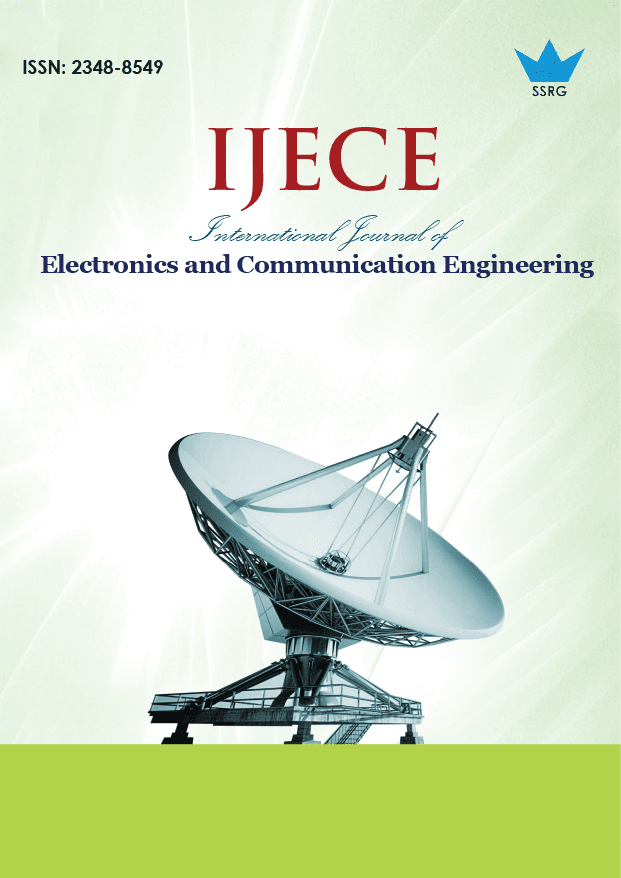Integrating Convolutional Neural Networks with Phase Coding for Robust Audio Steganography

| International Journal of Electronics and Communication Engineering |
| © 2025 by SSRG - IJECE Journal |
| Volume 12 Issue 10 |
| Year of Publication : 2025 |
| Authors : Thuraka Srinivasa Padmaja, Shaik Mahaboob Basha |
How to Cite?
Thuraka Srinivasa Padmaja, Shaik Mahaboob Basha, "Integrating Convolutional Neural Networks with Phase Coding for Robust Audio Steganography," SSRG International Journal of Electronics and Communication Engineering, vol. 12, no. 10, pp. 9-14, 2025. Crossref, https://doi.org/10.14445/23488549/IJECE-V12I10P102
Abstract:
Audio steganography is a crucial technique for secure communication, as it enables the covert insertion of data into audio waves. In order to increase robustness and imperceptibility, this study looks at two important approaches: the conventional phase coding method and a novel approach that combines phase coding with Convolutional Neural Networks (CNN). The study assesses several techniques for conversational, musical, and instrumental audio signals. Among the key performance metrics used are embedding latency, Bit Error Rate (BER), payload capacity, Mean Opinion Score (MOS), and PSNR. Architecture diagrams for both approaches are presented along with comprehensive experimental results, a comparative analysis, and an explanation of the practical implications. The significant improvements in robustness and imperceptibility demonstrate CNN-enhanced phase coding’s potential in modern secure audio communications.
Keywords:
Phase coding, Audio steganography, Convolutional Neural Networks, Secure communication, Signal processing.
References:
[1] Pranati Rakshit et al., “Securing Technique Using Pattern-Based LSB Audio Steganography and Intensity-Based Visual Cryptography,” Computers, Materials and Continua, vol. 67, no. 1, pp. 1207-1224, 2021.
[CrossRef] [Google Scholar] [Publisher Link]
[2] K. Bailey, and K. Curran, “An Evaluation of Image-Based Steganography Methods,” Multimedia Tools and Applications, vol. 30, pp. 55-88, 2006.
[CrossRef] [Google Scholar] [Publisher Link]
[3] W. Bender et al., “Techniques for Data Hiding,” IBM Systems Journal, vol. 35, no. 3-4, pp. 313-336, 1996.
[CrossRef] [Google Scholar] [Publisher Link]
[4] Akira Nishimura, “Data Hiding for Audio Signals That Are Robust with Respect to Air Transmission and a Speech Codec,” 2008 International Conference on Intelligent Information Hiding and Multimedia Signal Processing, Harbin, China, pp. 601-604, 2008.
[CrossRef] [Google Scholar] [Publisher Link]
[5] K. Gopalan, “Audio Steganography by Cepstrum Modification,” Proceedings. (ICASSP '05). IEEE International Conference on Acoustics, Speech, and Signal Processing, 2005, Philadelphia, PA, USA, vol. 5, 2005.
[CrossRef] [Google Scholar] [Publisher Link]
[6] Mihir Bellare, David Pointcheval, and Phillip Rogaway, “Authenticated Key Exchange Secure Against Dictionary Attacks,” International Conference on the Theory and Application of Cryptographic Techniques, Bruges, Belgium, pp. 139-155, 2000.
[CrossRef] [Google Scholar] [Publisher Link]
[7] C.E. Shannon, “Communication Theory of Secrecy Systems,” Bell System Technical Journal, vol. 28, no. 4, pp. 656-715, 1949.
[CrossRef] [Google Scholar] [Publisher Link]
[8] K. Muhammad et al., “An Adaptive Secret Key-Directed Cryptographic Scheme for Secure Transmission in Wireless Sensor Networks,” Technical Journal, University of Engineering and Technology, vol. 20, no. 3, pp. 48-53, 2015.
[CrossRef] [Google Scholar] [Publisher Link]
[9] Bolin Chen, Weiqi Luo, and Haodong Li, “Audio Steganalysis with Convolutional Neural Network,” Proceedings of the 5th ACM Workshop on Information Hiding and Multimedia Security, Philadelphia Pennsylvania USA, pp. 85-90, 2017.
[CrossRef] [Google Scholar] [Publisher Link]
[10] Thrassos K. Oikonomou et al., “CNN-Based Automatic Modulation Classification Under Phase Imperfections,” IEEE Wireless Communications Letters, vol. 13, no. 5, pp. 1508-1512, 2024.
[CrossRef] [Google Scholar] [Publisher Link]
[11] Timothy J. O’Shea, Johnathan Corgan, and T. Charles Clancy, “Convolutional Radio Modulation Recognition Networks,” 17th International Conference Engineering Applications of Neural Networks, Aberdeen, UK, pp. 213-226, 2016.
[CrossRef] [Google Scholar] [Publisher Link]
[12] Kaiming He, and Jian Sun, “Convolutional Neural Networks at Constrained Time Cost,” 2015 IEEE Conference on Computer Vision and Pattern Recognition (CVPR), Los Alamitos, CA, USA, pp. 5353-5360, 2015.
[CrossRef] [Google Scholar] [Publisher Link]
[13] Laith Alzubaidi et al., “Review of Deep Learning: Concepts, CNN Architectures, Challenges, Applications, Future Directions,” Journal Big Data, vol. 8, pp. 1-74, 2021.
[CrossRef] [Google Scholar] [Publisher Link]
[14] Farhad Mortezapour Shiri et al., “A Comprehensive Overview and Comparative Analysis on Deep Learning Models,” Journal on Artificial Intelligence, vol. 6, pp. 301-360, 2024.
[CrossRef] [Google Scholar] [Publisher Link]
[15] Made Sutha Yadnya, Bulkis Kanata, and M. Khaerul Anwar, “Using Phase Coding Method for Audio Steganography with the Stream Cipher Encrypt Technique,” Proceedings of the First Mandalika International Multi-Conference on Science and Engineering, pp. 1-10, 2022.
[CrossRef] [Google Scholar] [Publisher Link]

 10.14445/23488549/IJECE-V12I10P102
10.14445/23488549/IJECE-V12I10P102